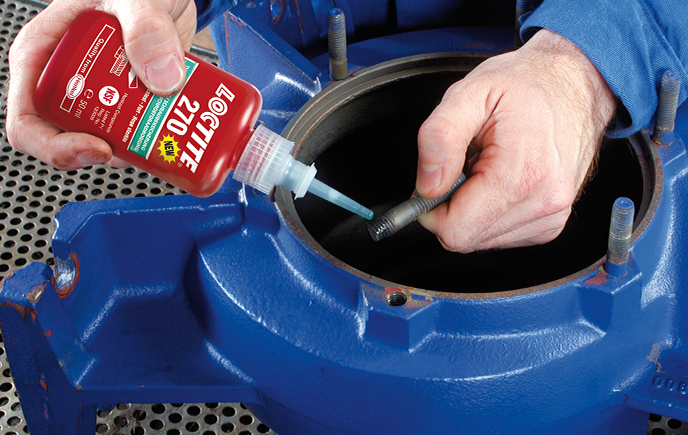Full steam ahead - Scottish distillery with Grundfos
There’s steam and there’s high-quality steam. There are pump solutions and intelligent pump solution...
When you’re operating machinery in a harsh environment, clampload retention is just one more thing you have to worry about. So an effective and reliable threadlocking solution would take a load off your mind.

There’s no shortage of threadlocking methods, because threaded assemblies inevitably relax tension and loosen. In a harsh environment that can be an even bigger problem, with no margin for error if you make the wrong choice.
So it’s important to consider all the alternatives. And once you have, it’s even more important to choose the right one.
Mechanical devices such as split pins and tab washers are really only designed to prevent the loss of nuts and bolts, rather than to maintain an effective clampload.
Friction devices are designed for the job but, while they offer some resistance to vibration, under extreme conditions they fail to perform well enough.
Locking devices, as the name suggests, do provide threadlocking capability. But they also bring their own problems. These tooth- and ribbed-flanged bolts, nuts and washers prevent self-loosening, but are expensive, can damage the contact surface, and require larger flange-bearing surfaces.
No wonder threadlocking adhesives are increasingly taking the place of traditional mechanical locking devices.
Threadlocking adhesives – such as the latest from LOCTITE – are the state-of-the-art solution for clampload retention in even the most extreme conditions.
As free-flowing liquids or semi-solid adhesives, they fill the gaps between mating threads of fasteners and joints. And once in place, even when the going gets tough they prevent unwanted movement, loosening, leaks and corrosion, and resist vibration – as independent testing proves.
LOCTITE submitted its threadlocking adhesives for comparative testing in a transverse shock and vibration machine. This uses pneumatic hammers to force relative movement of stressed parts, while the existing pre-stress force is measured for the number of load cycles. The characteristic clampload retention curves of the various threadlocking methods were then charted in figure 1, below.
As you can see, the LOCTITE threadlocker achieved better clampload retention than all other options.
The ribbed flange bolt came close, but its cost, the relatively large amount of space required for the flange bearing, and the damage it causes to the surface of the clamped parts around the bolt bearings, all make it a less attractive choice.
The graph also shows the bolt with a saw-toothed flange performed well. What it can’t show is that the flange teeth penetrated the bearings surface of the clamped material, and the head and nut were damaged during loosening.
This limits its application to parts with hardened surfaces that can’t otherwise be reliably connected. The LOCTITE threadlocker, on the other hand, can be used on any threaded assemblies, and cuts costs by replacing expensive special locking bolts or nuts – so less costly standard assemblies can be used.
Available as single component, semi-solid adhesives in a choice of viscosities and strengths, all LOCTITE threadlockers cure at room temperature to a hard, solid thermoset plastic, when applied between steel, aluminium, brass and most other metal surfaces.
Low-strength formulations are available for adjustment and calibration screws, meters and gauges, and thread sizes up to M80, and medium-strength options for machine tools, presses, pumps, compressors and gearboxes. For applications where frequent dismantling is unlikely, high-strength formulations are available.
LOCTITE threadlockers are being continually developed to extend their range of applications, and they’re now more effective than ever on passive substrates such as stainless steel. They also have greater oil tolerance so they’re less sensitive to improperly cleaned parts. All this – without compromising any of their other key properties, such as chemical resistance and shelf life – means they really do take a load off your mind.
Get the latest updates from ERIKS including:
Choose any or all of these via the ERIKS Subscription Centre!
Our Know+How brings together the best of the latest Know+How Hub articles in one easy to digest magazine, covering the following topics:
That's why its the leading magazine for maintenance engineers from ERIKS.
Want Know+How Magazine delivered direct to your door? Visit the ERIKS Subscription Centre to opt-in!
Take a look at our latest updates...
There’s steam and there’s high-quality steam. There are pump solutions and intelligent pump solution...
Looking for a custom Product quote? Need an answer to a Technical question? Looking for Careers/HR support? Want to work with us? Interested in our Digital Trading solutions? Have a finance question? Send us your enquiry and a member of the ERIKS team will be with you quickly.
We strive to deliver exceptional quality service and products. As part of this goal, we encourage customers to submit feedback on their experiences so we can resolve any issues and concerns.
At ERIKS we strive to deliver the best quality service and products. As part of this goal we encourage customers to submit feedback on their experiences so we can resolve any issues and concerns.
Call us: +441215086000
